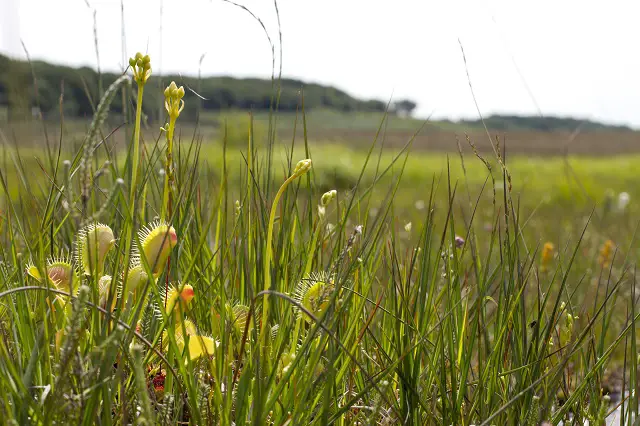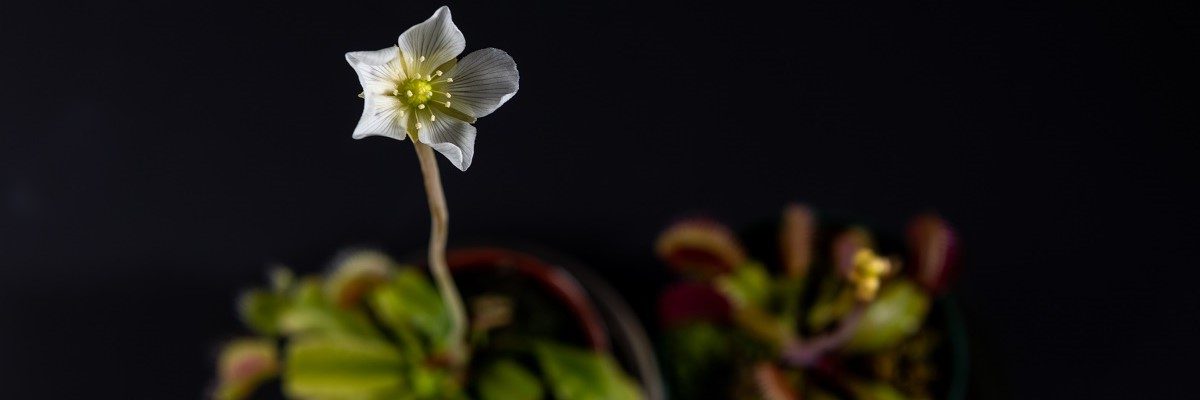Venus flytraps reproduce like many other plants. A flower’s stamens (the male flower parts attached to the tips of the filaments) are passed over by insects attracted to the flower, and pollen is carried to the pistil (the female flower parts). A cotton swab can be used to fertilize Venus flytraps by rubbing it along the fuzzy stamens and then rubbing the pollen on the pistils. The flowers die after a few weeks, but the fertilized seeds remain on the ground and grow.
Venus flytraps are capable of reproducing in other ways as well. In the case of a leaf that has fallen to the ground but is still attached to the rhizome, it will grow into a whole new plant. Venus flytraps in the wild develop large root systems that trigger the development of rhizomes into mature plants. It takes at least two years for a Venus flytrap to reproduce like this.
Venus Flytraps Do Not Kill the Pollinating Insects
The Venus flytrap has been observed not to harm the most important insects for pollination, even though scientists do not fully understand why it does so. Sweat bees are among them, along with long-horned beetles and checkered beetles. Scientists at North Carolina State University speculate that these insects may know how to get in and out of the flower fast enough or that there are different colored flowers for pollinators and prey. The key pollinators live long enough to carry out their duties on the Venus flytrap.
A Venus flytrap usually sprouts from seeds produced by the parent plant. It becomes its own organism, a cycle repeated over and over again. In this process, several factors play a role:
| Male – Flytraps produce pollen through their stamens, which are the male reproductive organs in plants |
| Insect Pollinator – This pollen will be attracted by an insect and then transferred to a female flytrap |
| Female – A female flytrap then produces fertilized seeds which, through its pistil, the female reproductive organ, spread on the ground to form new flytraps |
Apart from the unique position pollinators occupy due to being potential prey, this cycle isn’t that different from those of other plants!
Venus Flytrap Asexual Reproduction
In addition to sexual reproduction, flytraps also reproduce asexually when a new plant appears without the help of any other flytraps or flowers.
Asexual reproduction occurs when the roots of a plant grow larger and form a bulb from which a new plant will sprout.
| Rhizomes are horizontally branching underground roots produced by the primary plant. |
| Child plants are grown from the roots of the rhizome. |
| Some of the leaves that are attached to the rhizomes fall off and form a new carnivorous plant. |
| As the rhizomes mature, they separate from the mother plant and become independent plants. |
Using this technique, a single plant is capable of taking care of the entire reproduction process.

What Is the Reproduction Period of a Venus Flytrap?
Like the Venus flytrap, Perennial plants experience the same stages of growth year after year for as long as they live.
Germination Stage
Planting seeds in the spring begins the process of germination. The germination process is slow, and it is often between two and three weeks before the seed begins to grow. The seeds do not germinate at the same time. After a few seeds germinate, it may take several more weeks for seeds planted simultaneously to germinate. Once the seed germinates, it produces a sprout with minuscule, fully-functional traps. Plants grow longer and thinner as they push through the soil and raise their traps to the sky. The size of the plant for the first two years of its life is less than one inch.
Blooming Stage
Some plants reach flowering size within a year, but it typically takes between two and four years for flowers to appear. Small white flowers appear on the plant during the summer months. At this stage, the traps will measure about half an inch long and can capture insects like flies, ants, and bees. The plant grows larger in its third year, typically reaching a height of about 2 inches.
Reproduction Stage
In the course of its life cycle, a Venus flytrap can reach full maturity at any point between the fourth and sixth years. The plant’s flowers are located at the very top of its stalk, making them ideal for pollination without trapping insects. These flowers produce many tiny black seeds. The seeds mature approximately four to six weeks after being successfully pollinated.
Dormancy Stage
Venus flytraps need to enter a dormancy period every winter for three to five months to ensure their survival. In conjunction with colder weather and less daylight, dormancy is triggered. Even though the Venus flytrap appears to be dying, it is actually preparing itself for a long rest period. Leaf production slows, eventually ceasing altogether, and most of the leaves turn black. With an increase in temperature and higher levels of sunlight in the spring, the plant emerges from dormancy once again. Healthy Venus flytrap plants can live for seven years on average.

Conclusion
In general, it takes three to four years for Venus flytraps to reach maturity from seeds. Plants begin to produce flowers and can continue to grow in size if they are given the right care. Appropriate lighting, watering, and soil conditions can affect the time it takes Venus flytraps to reach adulthood.
The following chart summarizes the expected size of a Venus flytrap over a period of several years.
| Age | Trap Size |
| Seedlings | Tiny |
| 1-2 years | 1/8 inch |
| 2-3 years | 1/4 inch |
| Three years | 1/2 inch |
| 4+ years | 1 – 2 inches |

